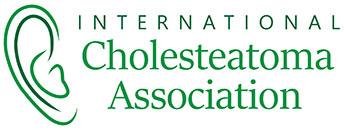So what is Cholesteatoma?
Cholesteatoma is a disease where an abnormal growth of skin cells grow in the ear causing damage to the delicate structures inside the ear. It is not cancerous and typically grows in the middle section of your ear, behind your ear drum. Symptoms of cholesteatoma include repeated ear infections, discharge from the ear and hearing loss. If left untreated cholesteatoma grows and eats away at the structure of the ear. The only treatment is surgery.
In normal circumstances the ear skin migrates form the ear drum outwards and does not cause any problems. If this migration is disrupted it can create a retraction pocket which traps the skin within a sac and the two events occurring together are called a cholesteatoma. Cholesteatoma can also be caused if the skin cells migrate in the wrong direction and are trapped in the middle ear.
There are two main types of cholesteatoma. Congenital cholesteatoma is caused by skin cells that have been in the wrong place since birth. Acquired cholesteatoma occurs at some point possibly due to an infection or inflammation. The most common type is acquired cholesteatoma.
It is thought that for every 1000 people seen for ear infections in ENT, about 1 will have cholesteatoma. It is said that about 1 in every 16,000 people have cholesteatoma which would be about 4000 people in the UK (with a 1000 of those being children).
There is a difference in how cholesteatoma behaves in children compared to adults. In children the cholesteatoma is a lot more aggressive and can therefore cause more damage to internal structures. There are a number of reasons for this. The main reason is because the ear presents new virgin territory for the cholesteatoma to spread, and because of the greater number of air cells inside children’s bones which allows easier conditions for the cholesteatoma. Also the internal structures are a lot smaller and less well developed which makes them vulnerable. In adults, the bone is thicker due to increased number of infections which makes the cholesteatoma slower to grow and more contained.
There are a number of theories on how cholesteatoma is formed. The first is that the ear drum becomes retracted and skin on the ear drum travels into the middle ear. The second is that skin cells build up because the ear is not removing dead skin cells to the outside of the ear. More research is needed, although it is possible there are multiple methods of acquiring cholesteatoma.
Whatever theory explains your cholesteatoma, a cholesteatoma has a special enzyme which in effect ‘eats’ bones (hearing bones, bones that control balance, bone covering the facial nerve and the skull protecting the brain). Therefore, treatment to remove cholesteatoma is very important, and we are lucky that we have access to modern medicine around the world.
Treatment for cholesteatoma is through surgery to physically remove the cholesteatoma sac. The aim of the surgery is to create an ear that is cholesteatoma free, and dry (not infected). In some cases repeated surgeries may be needed to completely remove the cholesteatoma. The way that the cholesteatoma attaches itself inside the ear means that the disease has to be meticulously scrapped off or removed with a laser. Surgery can last many hours. The challenge is to maintain the hearing bones and other structures within the ear whilst removing the cholesteatoma. Ultimately the main aim is to become cholesteatoma free, hearing preservation or improvement is a secondary aim.
There are two main types of surgery – canal wall up and canal wall down. Typically canal wall up is performed a few times to try and remove the cholesteatoma. If after a few attempts the cholesteatoma is not removed, then a canal wall down procedure is performed. The latter may be performed in the first instance if the disease is widespread.
Canal wall up procedure allows for preserving the back wall of the ear canal, thus maintaining normal anatomical relationship for any future surgery to improve hearing (ossiculoplasty). The downside is that potential recurrence cannot be easily identified, therefore a second look operation may be required. Some hospitals are using a diffusion weighted MRI scan to identify recurrences, avoiding the need for repeat surgery to monitor for a recurrence. The scans may not be available in all hospitals and require a degree of expertise in interpreting.
The main advantage of the canal wall down surgery is that it allows for greater opportunity to clean the ensuing mastoid cavity in the outpatient clinic and identify problems earlier.
There are some risks to having surgery such as damage to the facial nerve, removal of ear bones which may affect hearing, damage to the balance organ, tinnitus, damage to the nerve supplying taste buds in the front part of the tongue. These risks can also happen if the cholesteatoma is left untreated. However, surgery is needed to prevent the cholesteatoma from entering the brain and causing meningitis.
Cholesteatoma requires regular follow ups, and canal wall up procedures require a ‘second look’ surgery to see if it has returned. There have been cases of cholesteatoma returning years and even decades later.
For a simple guide to cholesteatoma, here is a you tube video that gives a brief overview:
